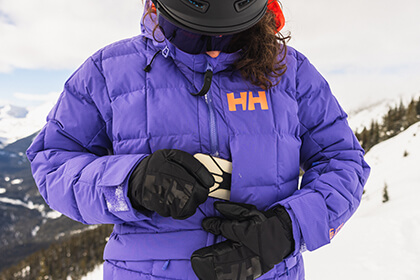
How to wash synthetic insulators: 5 easy steps
Want to keep your insulator performing at its best? Wash it once in a while.
November 03, 2023
4 min read
A synthetic insulator, often casually referred to as “a puffy” or “a fill layer”, is a staple of the outdoor wardrobe. Just like other performance apparel, a little care and maintenance can go a long way. In this guide, we'll cover how to wash your synthetic insulators in 5 easy steps.
WHY WASH YOUR INSULATOR?
A synthetic insulator, often casually referred to as “a puffy” or “a fill layer”, is a staple of the outdoor wardrobe. If your insulator's looking a bit grimy, then it's time to take some action!
Dirt, grime, sweat, snot, dog hair, sand, smoke can all limit the insulation functionality of your jacket. If these remain embedded in the fabric fibers, the strength and integrity of the surrounding shell fabric – and the insulation contained inside – can cause the fabric to tear, a less than desirable odor and more.
So while we feel confident in the pro-level quality of our gear, we also know that maintenance can bring it back to its best, keeping you warm when the cold snaps hit.
TYPES OF SYNTHETIC INSULATION
LIFALOFT™
Lifaloft™ is the result of our collaboration with Primaloft®, in which we combined our proprietary Lifa® technology (the naturally hydrophobic and lightweight fiber we use to manufacture our base layers) with the warmth and insulation properties of Primaloft® synthetic insulation. Introduced in 2018, Lifaloft™ is lighter and still warmer than standard synthetic insulation due to the structure of the Lifa® fibers.
PRIMALOFT®
Primaloft® is an industry-leading insulation company, with whom we partner. We incorporate their top-quality levels of synthetic insulation into various pieces throughout our outdoor, ski, and sailing lines.
STANDARD & RECYCLED INSULATION
We also utilize blown-in polyester insulation, as well as recycled polyester insulation.
HOW TO WASH SYNTHETIC INSULATORS
1. Read the care label
Locate and read the manufacturer care label on your jacket(s). For Helly Hansen jackets, that label is most often found on the left hip of the jacket.
The common “DO NOTs” for synthetic insulators:
- Do not bleach;
- Do not dry clean;
- Do not iron;
- Do not use standard laundry detergent;
- Do not use fabric softener
2. Prepare the jacket
Close all fasteners, including velcro straps and zippes. Then place your insulator in a front-loading washing machine or a top-loading machine without an agitator in the middle.
Different fabrics require different care and cleaner. All technical apparel should be washed by itself or with same-category items. Multiple insulators can be washed together as long as they are not mixed in with other types of fabrics or apparel (e.g. cotton, rain shells, base layers, denim, wool, etc.).
3. Use a technical cleaner
Avoid laundry detergent. Instead, replace it with a technical cleaner specifically designed for cleaning synthetic fabrics. We recommend Grangers Performance Wash or a similar product. Each product has its own measurements, so make sure to follow the instructions on the bottle for specific amounts and directions.
4. Use the right setting
Most often, use medium temperature water, and a medium-strength cycle. Consult the care label to be sure.
5. Dry the jacket
Follow the care label for specific drying instructions.
If the instructions are not clear, a common method is to tumble dry the garment(s). Make sure to stick to a low or medium heat. Extremely high heat can damage some synthetic fibers and materials.
When the tumble dry is nearing the end of its cycle, throw in a few dryer balls or clean tennis balls with the insulator. These break up any clumps of insulation that may be sticking together, enabling the jacket to evenly redistribute the insulation.
How to add water repellency
If your jacket has any water-repelling functionality, it probably has a coating on the outside. This coating is known as a Durable Water Repellent (DWR) treatment, and enables water droplets to bead up and roll off. It's normal for DWR to fade over time, especially when exposed to dirt, grime and sweat. When this happens, you might notice that your jacket starts absorbing moisture instead of repelling it.
Remember that insulators are not designed to be waterproof (that is the job of a shell jacket), but it doesn't hurt to give your insulator the ability to shed some precipitation. Here's how to do it:
- Follow steps 1-4 above if not done so already;
- Then run another cycle; this time using a down reproofing product, like Grangers Clothing Repel;
- Lastly, follow step 5 above to activate the water repellency.
How to store your insulator
And finally, be sure to store your synthetic insulators in a way where they can be freely expanded. Compressing your insulators over an extended amount of time can have a lasting impact on its ability to re-loft.
Need more washing tips?
If you love the outdoors as much as we do, you'll probably find some of your other gear requires a little specialized care. From base layers to shell jackets to down jackets and beyond, our product care hub has got you covered.
First, consult the individual garment’s care label for any specifics. Then lean toward caring for the more sensitive insulation or material… in this case, down is more sensitive. It is common to have synthetic insulation and down in the same garment; those garments are often referred to as “hybrids.” For information on caring for down garments, you can read this guide.
As a general rule of thumb, gear care is centered around fabrics and materials, not the activity for which a garment was originally constructed. In short, if a garment has synthetic insulation, you can wash with the same process, regardless of “end use.” So, you can wash your “dog-walking” puffy the same way as your “summit-ready” insulator.
No need to panic. A couple washes with a gentle, technical cleaner (ex. Nikwax Tech Wash) will remove all the residue left behind by your standard detergent, allowing your jacket and any existing DWR to be refreshed, re-ensuring even distribution of insulation, and maintaining fabric and structural integrity.

October 22, 2025 5 min read
How to Choose the Best Rain Jacket
Find your perfect rain jacket with our complete guide. Compare waterproof vs water-resistant, breathability, and features for hiking, sailing, and city use.

October 06, 2025 4 min read
Duffel Bag Size Guide
Find the best travel, carry-on, or camping duffel bag with our size guide. Learn how to choose the right size for any adventure, from 30L to 90L+.

October 02, 2025 3 min read
Choosing the Right Winter Gloves for Outdoor Sports
Find the perfect winter gloves for skiing, hiking, and running. Expert tips on materials, fit, and features to keep your hands warm and protected.

September 29, 2025 4 min read
What Does Moisture Wicking Mean?
Discover how moisture wicking works, the best fabrics for outdoor adventures, and why this technology keeps you dry and comfortable during any activity.